
Day 1 — October 12, 2020 Monday
Hesitancy has prevailed during these many months of Covid-19, and it prevented me from traveling last spring to visit the Blue Ridge Parkway during one of my favorite seasons. But I finally relented this fall, and a few weeks ago headed to the mountains with several face masks, rubber gloves and hand sanitizer, vowing to stay away from other people, and generally just keep to myself when doing anything. No casual conversations with other photographers, no hanging around McDonald’s for meals; simply staying as safe as I could. There was a constant unsettled feeling every time I stepped out of the confines of the car, even to the point of holding my breath as maskless motorcyclists roared by, even though I had a mask on! I suppose I may have been a bit over cautious, but my thoughts are it is easier to avoid contracting the disease than trying to recover from it, especially since I am among those at higher risk. So this short, three-day trip was different from any other trip, long or short, that I have ever taken in that the freedom to fully enjoy this wonderful season was stripped from the experience. Worry seemed to outweigh wonder.
After setting up camp, the first stop was Graveyard Fields just to scout out the afternoon light since I had never been there at that time of day. There were some breaks in the low clouds that occasionally drifted across the valley through the trees with just a bit of sunlight, so things looked interesting. But the parking lot was completely full, and it took several passes to get lucky and find an empty space.
The 70-300mm lens was used to isolate small sections of the valley that seemed to have a nice arrangement of both bare and colorful trees, along with a few fir trees sprinkled in, and just waited for differing amounts of fog and sunlight. Depending on where and how thick the fog was as it drifted through, made for completely different images. The most important element was there was no fog between the camera and bank of fog in the distance, creating a cleaner view. Various compositions were tried, but the one above seemed to resonate more and stayed with it for quite a while, clicking off several frames as the fog rolled in and out. Sometimes it rolled through along the top of the frame, other times more toward the middle; but the best frames seemed to have a bit of soft, directional sunlight peaking through the fog, highlighting the treetops.

After it seemed no more fog would roll through Graveyard Fields (MP417), I leisurely continued south another 34-miles, occasionally stopping to either scout a possibility for sunset, or to shoot a vignette against a rock face in shade; something I’m always keeping an eye out for. The eventual destination was an interesting rock wall at Waterrock Knob (MP451) that I had shot many years ago, and found that the young tree from that time had succumbed to the harsh environment at the high altitude, and was covered in something similar to Spanish Moss. But the design of it still held my interest. Things never stay the same, and over time, the same subject can result in a wildly different photo. I have always been drawn to this type of image, a solitary subject within the elements of an abstract natural design. It is probably due to the early influences of Eliot Porter on what things I seek to put in front of the lens apart from the grand, scenic views.
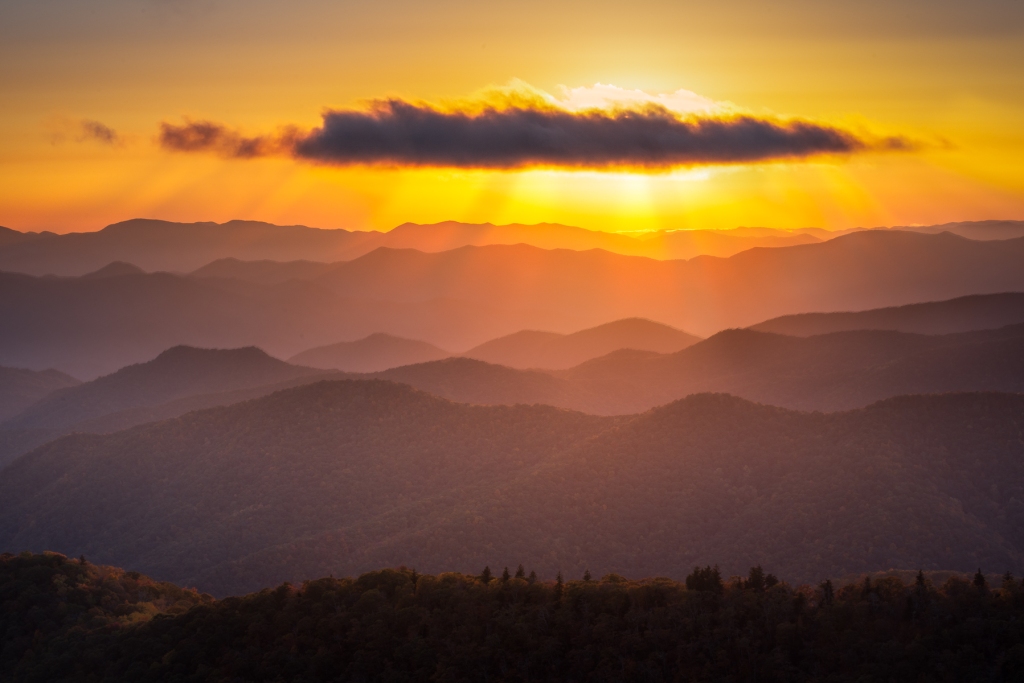
Then it was back north to Cowee Mountains Overlook (MP431), probably one of the most popular destinations on the Blue Ridge Parkway for sunset views, with layer upon layer of mountain ridge lines fading out to the horizon. It did not show much promise with basically a single cloud, but it did end up providing some good atmospherics as the sunset developed, and on towards dusk. Shooting required several differing exposures for each composition because of the wide dynamic range of a bright sunset sky and backlit mountains. Each composition seemed it could be widened or narrowed to produce another decent composition, and the images taken that evening included ten different focal lengths ranging from 70mm, through 85, 90, 100, 130, 135, 150, 185, 240 and 300mm! All the ridge lines can be grouped in so many differing combinations along the horizon, and each seems better than the one before.
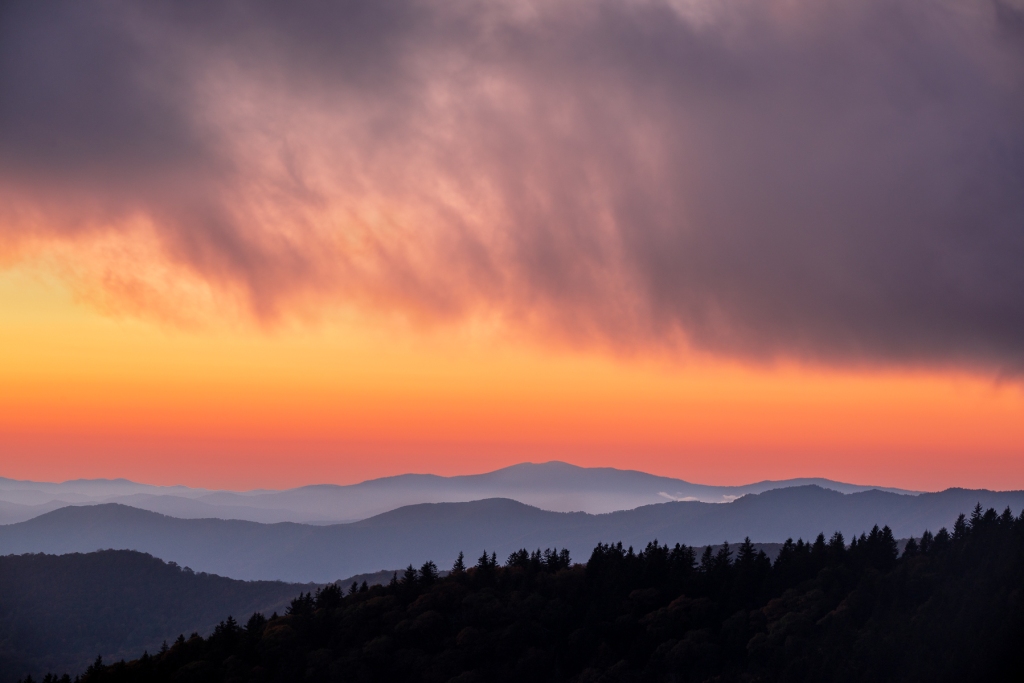
But when the light in the sky was completely finished, I turned my attention to the beautiful autumn palette of the varied trees and bushes just below the overlook that was difficult to see when the sun was glaring directly toward you. I remember using some pretty long exposures in the desert when it seemed it was almost dark, and the colors of the canyon walls were recorded as nothing less than astounding. Since there was barely a breeze, I thought to try the same technique here, and although difficult to see through the viewfinder in the gathering darkness, a small, moss covered tree stood out among all the other bushes there. I pushed the ISO to 400, rather than the usual ISO 100 to make sure the exposure wasn’t too long with a small enough aperture to maintain sharpness throughout the frame as much as possible (4-seconds @ f/16). And just as in the desert years ago, the colors were intensely recorded, the result looking much better on the back screen than through the almost completely dark viewfinder.
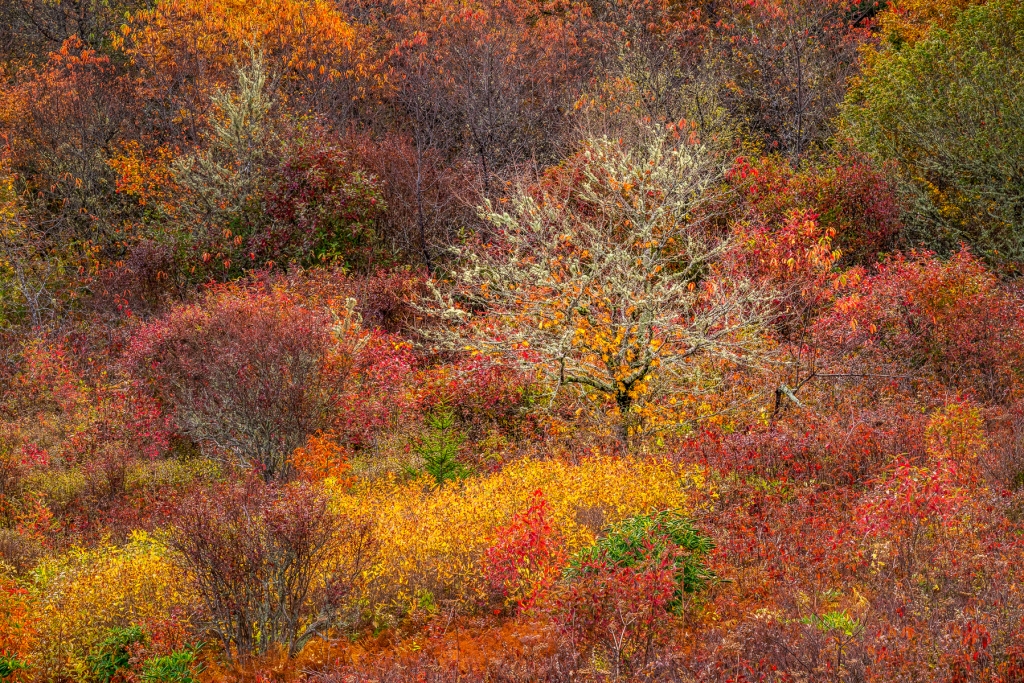
As other people packed up and drifted away, I boiled some water for a hot freeze-dried camp meal, and by the time dinner was finished, it was almost completely dark. Stepping out of the car with my eyes adjusted, I could actually see the Milky Way! There was always the hope that I could, and brought along a portable, battery powered LED light panel to illuminate something of interest in the foreground of a shot, and found a nearby fir tree and some grasses to try it on, lighting them from both the left and right sides of the camera position. It was turned on for just a few seconds during the 25-second exposures, acting more like a strobe, with quite a few poorly lit frames until finally figuring out the correct amount of time to properly light up the foreground. The camera was able to pick up the glow from what I believe was far away Cherokee, NC, as well as the Milky Way. Two of these were combined in separate layers in Photoshop using layer masks to add the missing illumination of the other frame.

I tried another tree after the first, but a very moist cloud quickly rolled in blocking the Milky Way, and leaving a thick layer of moisture on my gear. I took that as a sign that I should call it a day and began the drive back to the campground through intermittant fog, with one additional stop along the way. I had scouted a singular standing snag at another overlook nearer the campground, and hoped to use it in another Milky Way shot. But, the day’s shooting was truly over because the view did not line up with the stars to do so.
So all in all, a good afternoon of shooting that first day, which is generally somewhat more difficult, as my vision adjusts to seeing photographically. Normally, while at home, a scene may stand out for future photographic possibilities when conditions are right, but it is not the constant visual search for subjects as I drive along unfamiliar roads. So many images have come about after having been seen while driving, and turning back.
A friend of mine has the luxury of scouring for subjects as the passenger in the car, without the responsibility of keeping the car on the road. For her, she simply shouts, “STOP!!” Could that be the real reason behind the development of cars that drive themselves?

Day 2 — October 13, 2020 Tuesday
The second day of the Blue Ridge Parkway trip began with heavy fog, but it began to break up just after daybreak, thereby blocking any possible color for sunrise, while any lingering atmospherics in the valley or nearby, was short lived. As it turned out, after it did dissipate, the skies cleared leaving the rest of the day under brilliant sunshine and blue skies, and had me searching for shade and rock walls that might have some interesting subjects and less harsh light.
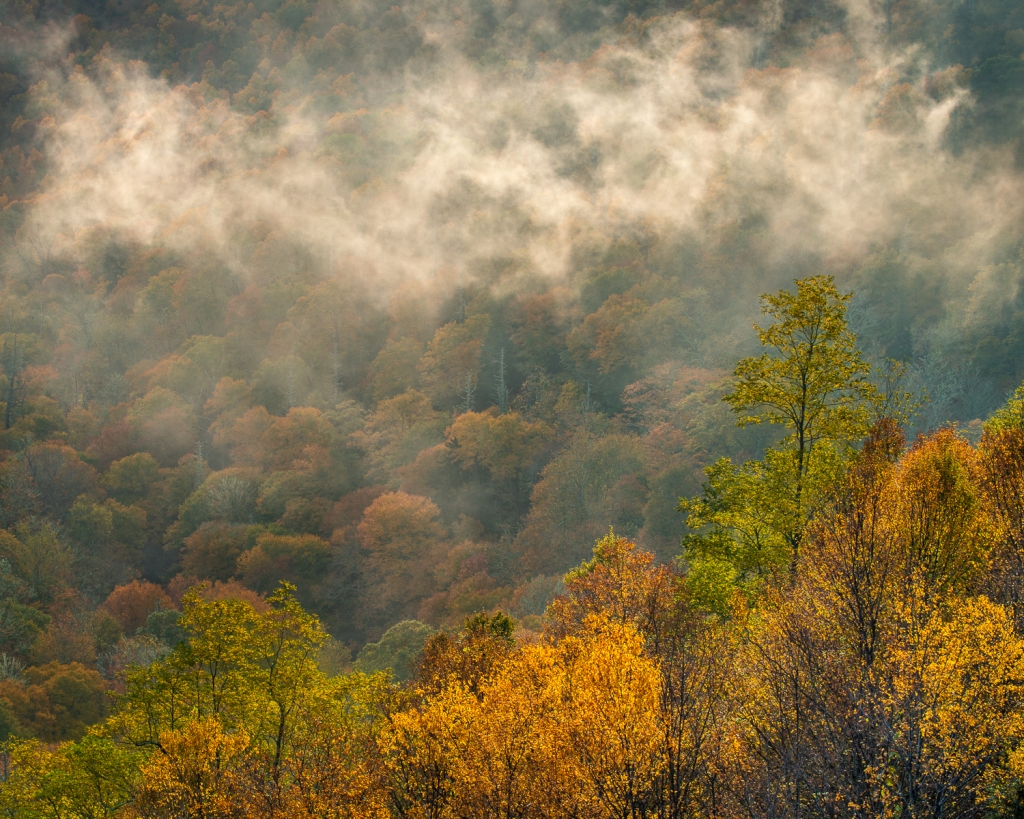
I began the day at the East Fork Overlook, driving there in heavy fog and arriving while still dark. I watched as the sky brightened to see mostly fog, disappointed that there would be no color at sunrise, but began taking photos as it broke apart, drifting through the valley below, sometimes lit by the sun and obscuring the view of many areas. So it was a constant battle against a very changeable scene, swinging the 70-300mm lens from one spot to the next while having to bracket exposures quite a bit because of the wide tonal range between bright sunshine and dark shadows deep in the valley. The image above was one of the very few that illustrated both the sunlight and the quickly moving areas of fog.
The image below shows how difficult it can be to single out a subject among the chaos of trees and color across the valley. Sometimes the subject can be a bare, solitary tree while surrounded by those still clinging to their leaves. But it was the soft, fleeting, filtered light raking across the hillside that creates the gentle definition within the elements.

After a quick breakfast of oatmeal, I traveled from Graveyard Fields to the Parkway’s southern terminus at Great Smoky Mountains National Park, and then up to Newfound Gap. The hope was to revisit a spot adjacent to the parking lot where I had taken one of my earliest satisfactory photographs after switching to digital a month before in 2012. It was a beautifully colored, crumbling slate wall (photo below) that now had signs indicating that the area was closed! But it was completely in the harsh light of midday and lacking the yellow plants from that year, and there was nothing else to coax the camera out of the bag.
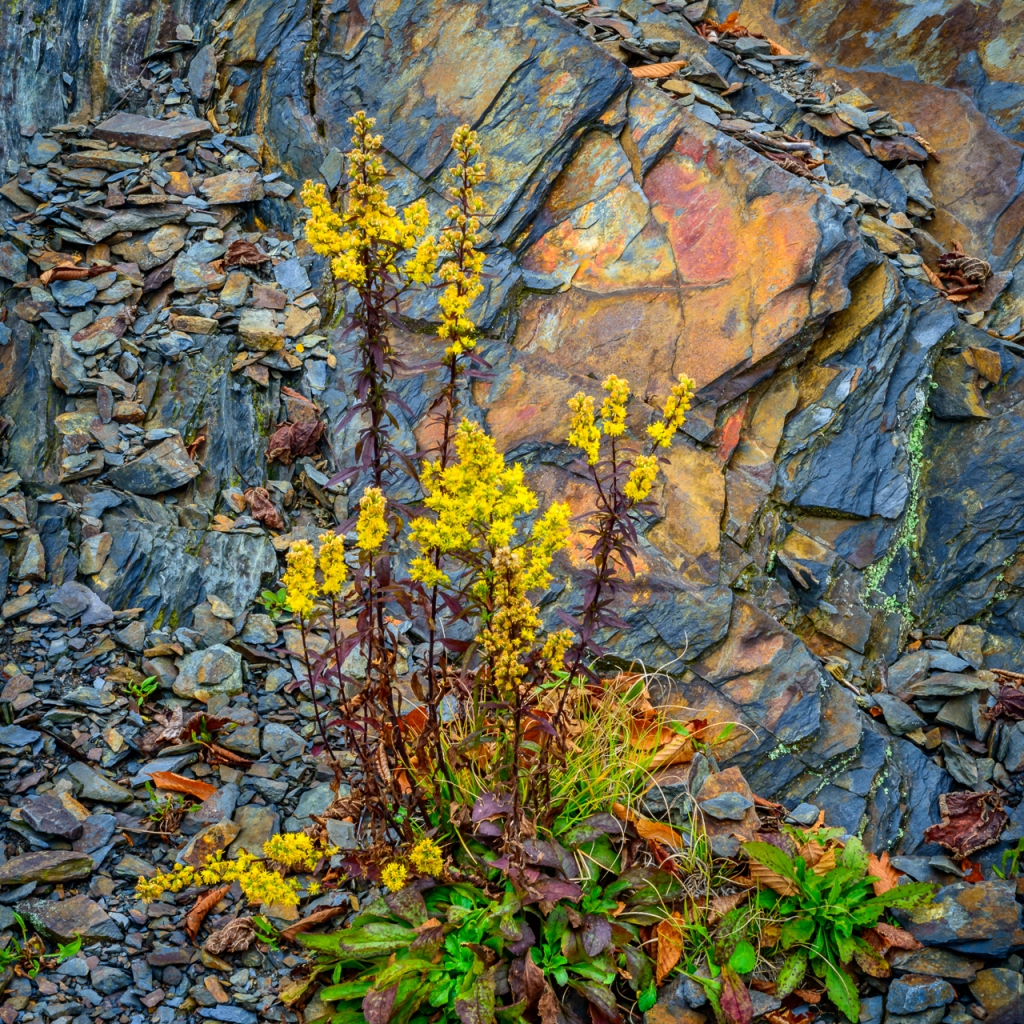
So I spent most of the remaining afternoon working my way back toward Graveyard Fields, with many stops along the way to investigate any possibility that jumped out as I drove. There was no hurry, so quite often, nothing came of some of those stops. The first was at a pullout along the Oconaluftee River where I spotted an area of red leaves among the other fall colors. Although I liked the straight image of backlit leaves and leaning trunks, I tried an Intentional Camera Movement (ICM) as well, that provided a more abstract view of the same scene. These ICM’s are not a one and done endeavor; rather, they are an exercise in a learning curve; finding what works and what does not. Moving up or moving down, or both; too much or not enough movement; or adjusting the initial camera placement for balance within the frame, all have an affect on the final image. Simply stated, it’s trial and error until you’re finally satisfied with the result.
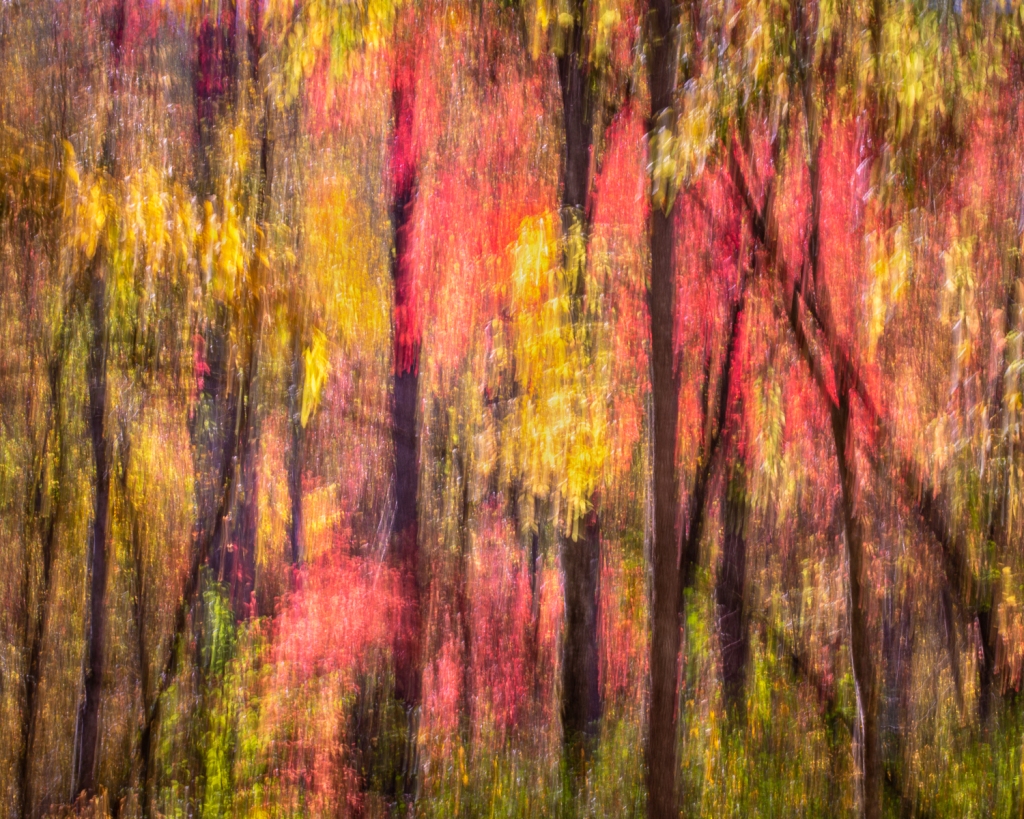
So, continuing back along the Blue Ridge Parkway, there were many stops when something caught my eye with a few of them below. The images on either end were basically “no-brainers” in that they were seen just about the way they appear in the frame. However, the one in the center was a frame at the end of a series of images taken of a larger section of the wall containing this lighter intrusion. Each image of the large section left me with ambivalence, and it wasn’t until I really zoomed in more tightly, was I satisfied and ready to move on. In the larger frames, the tiny rhododendron was insignificant, when the purpose was for it to be more prominent. It was the long white intrusion that overpowered it, and by zooming in, the rhododendron was on a more equal footing with the intrusion, and created a better balance between the two objects, as well as the image itself.
One note here though, in each of these photos, a polarizer was used to eliminate any glare from the leaves, and in the case of the center image, the very wet rock wall. The difference was quite dramatic, and regret not having taken a frame without its affect to illustrate the point.
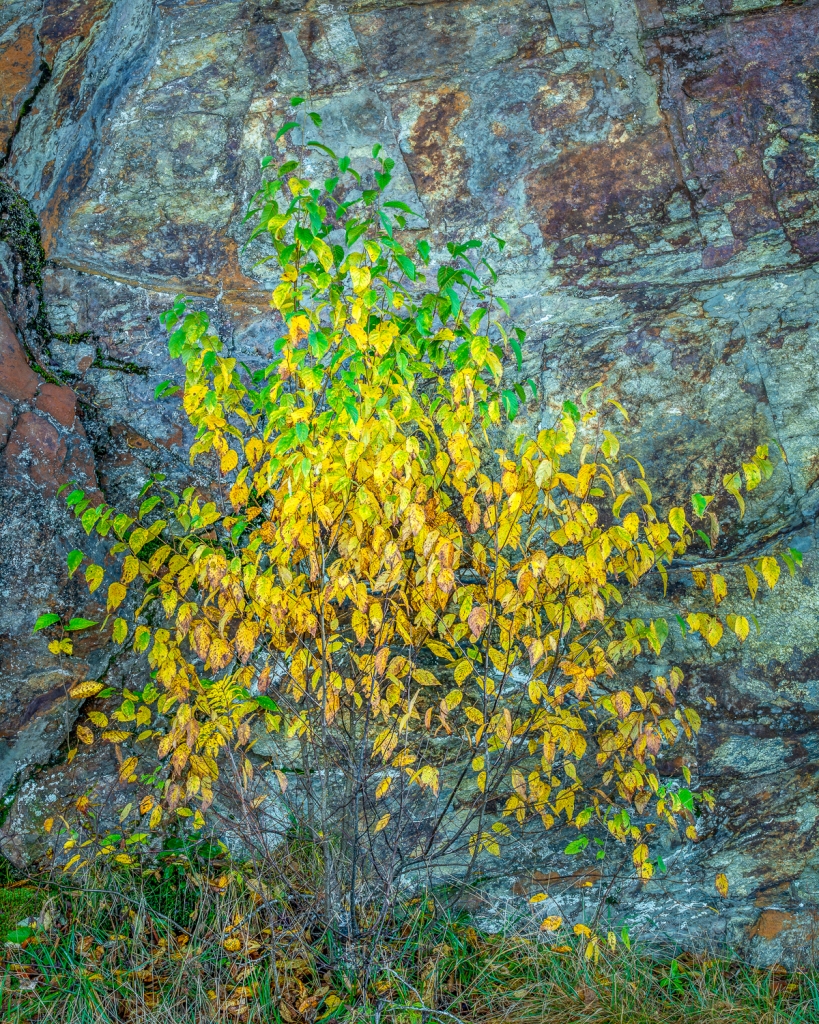

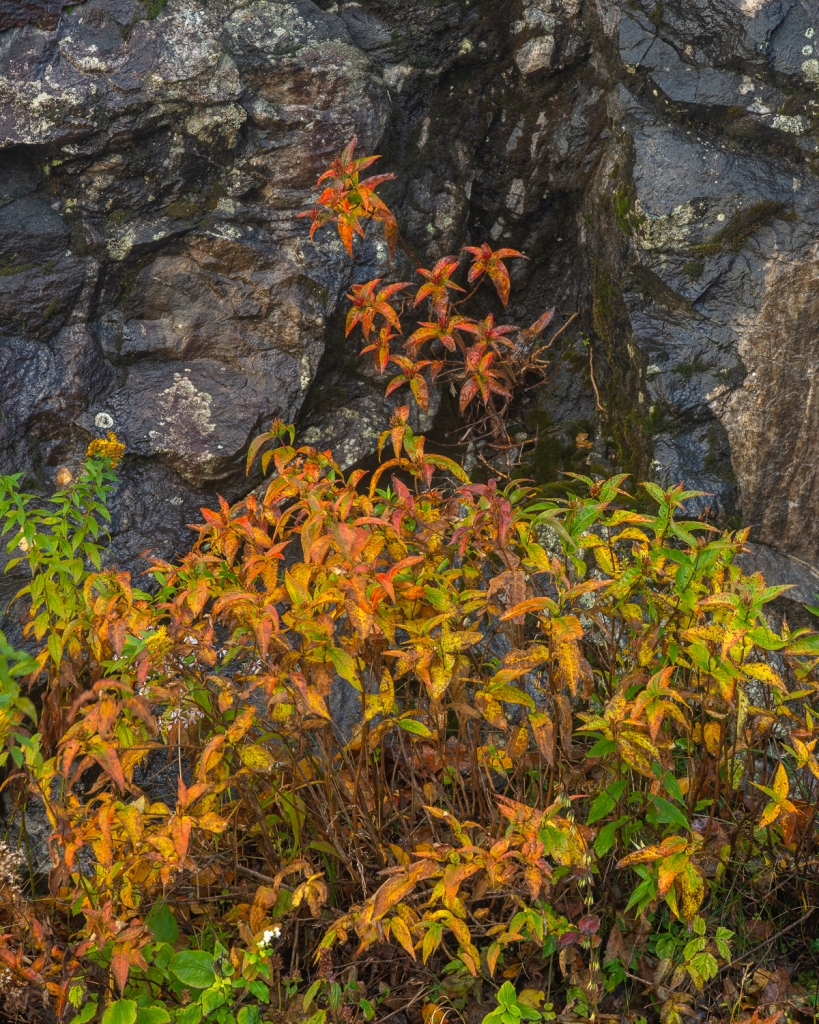
Since the sky refused to produce any clouds, I opted to go beyond my preferred sunset location, and drive on to Graveyard Fields once again. It was most likely just to kill a bit of time before there was a need to be at a sunset location, but there was an interesting shaft of light through the center of the valley that encouraged the camera out of the bag. But it wasn’t enough to skip doubling back to the Cowee Overlook again.

Since there were still no clouds at all when I left Graveyard Fields and returned to the Cowee Overlook, I shot directly into the sun to show the ridges and some backlit bushes nearby, but the internal refractions were a menace. So I took one image with my hat actually in the frame at the top right corner to get a frame without those annoying circles. The idea was to combine one with, and one without the refractions in Photoshop. It wasn’t too difficult, and was very happy with the result. But, and this is a very big but, zoomed in at 100% back in Lightroom, I noticed that the branches and leaves of those nearby, backlit bushes, had ghost images because I had combined that area using a brush that was not at 100% opacity! So the whole process needed to be repeated and extra, unnecessary time was spent in front of the computer!!! There was a lot of tedious blending around the middle fir tree, and I was annoyed with myself for having flubbed the initial processing.

After the sun dropped behind the distant ridge line, I waited a while for the color to intensify along the horizon and the light values to even out more toward the darker ridges, and clicked off a three panel pano (top) using a two-stop split ND filter to darken the sky. There is nothing that illustrates the distances involved than the ridges fading as they get further away, with the bonus of haze between each ridgeline. There was no hanging around afterward to do some more Milky Way shots because of the cooler temperatures and a stiff breeze that would have made any foreground trees a blur with the necessary 25 or 30 second exposures. So the day ended with another camp meal back at the tent, and an early night looking forward, with fingers crossed for clouds, to the final sunrise of the trip the following morning.
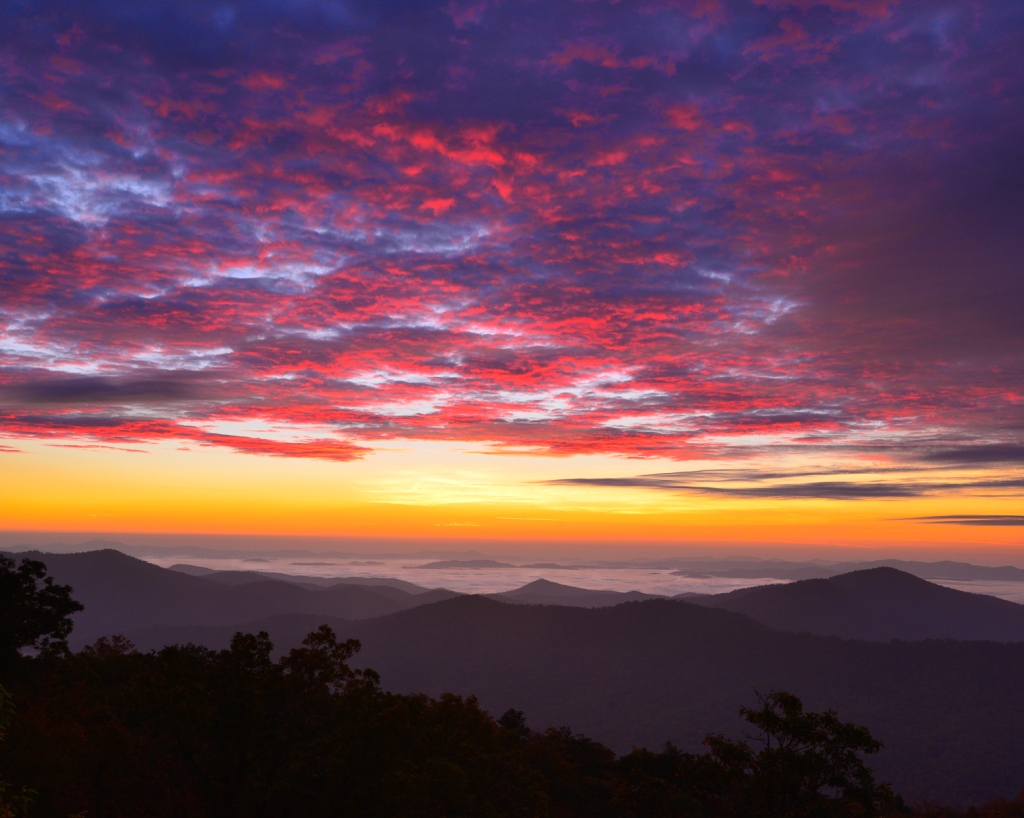
Day 3 — October 14, 2020 Wednesday (Final)
The final morning of the trip turned out to be difficult because, like the previous sunset, there were no clouds, so sunrise was a bust. East Fork Overlook was again the choice that morning only because I have yet to witness one there that could be considered spectacular. In fact, it seems every time I go there, it is either totally clouded over, or completely empty of clouds. One of the very first sunrises I witnessed from the Blue Ridge Parkway was from the other go to sunrise spot, Pounding Mills Overlook (above), along with a herd of other photographers. It turned out to be one of the most memorable not just of that trip in 2013, but probably one of the best I’ve ever witnessed!
But as the sky lightened in the east without the benefit of any of the beautiful color as in 2013, the color began to appear on the opposite hillside, several frames were taken of varying exposures in hopes combining a few to properly recreate the scene as it was. One frame was to be used for the sky and another for the forest and ridge lines as they flowed toward the horizon. Some additional “painting” was done to accentuate the directionality of the light on the trees.
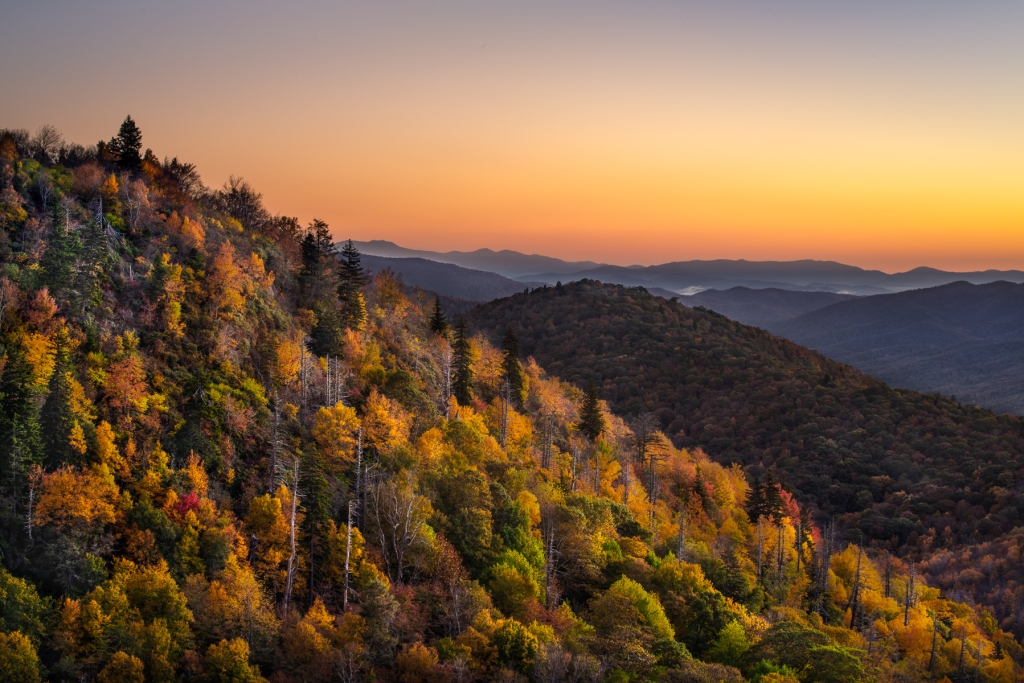
So shortly after the sun peaked above the distant ridge line, I turned my attention to the opposite side of the valley to compose something with a singular focal point among the side lit trees. There is always a trade off when it comes to putting a frame around the chaos of a hillside. One slight movement of the camera or the zoom may fix one problem with the composition, while creating an entirely new problem. Taken one minute apart, these two images are an illustration of the conundrum. The first of the two on the left was framed to show how the sunlit autumn trees wrapped around the two snags in a semi-circle, but the orange tree at the bottom middle seems to compete with the snags as a subject. Moving in tighter for the second frame to eliminate that tree appears to have resolved the issue, but at the same time, the idea of the trees framing the snags has been diminished. And that’s the way it remained much of the morning.

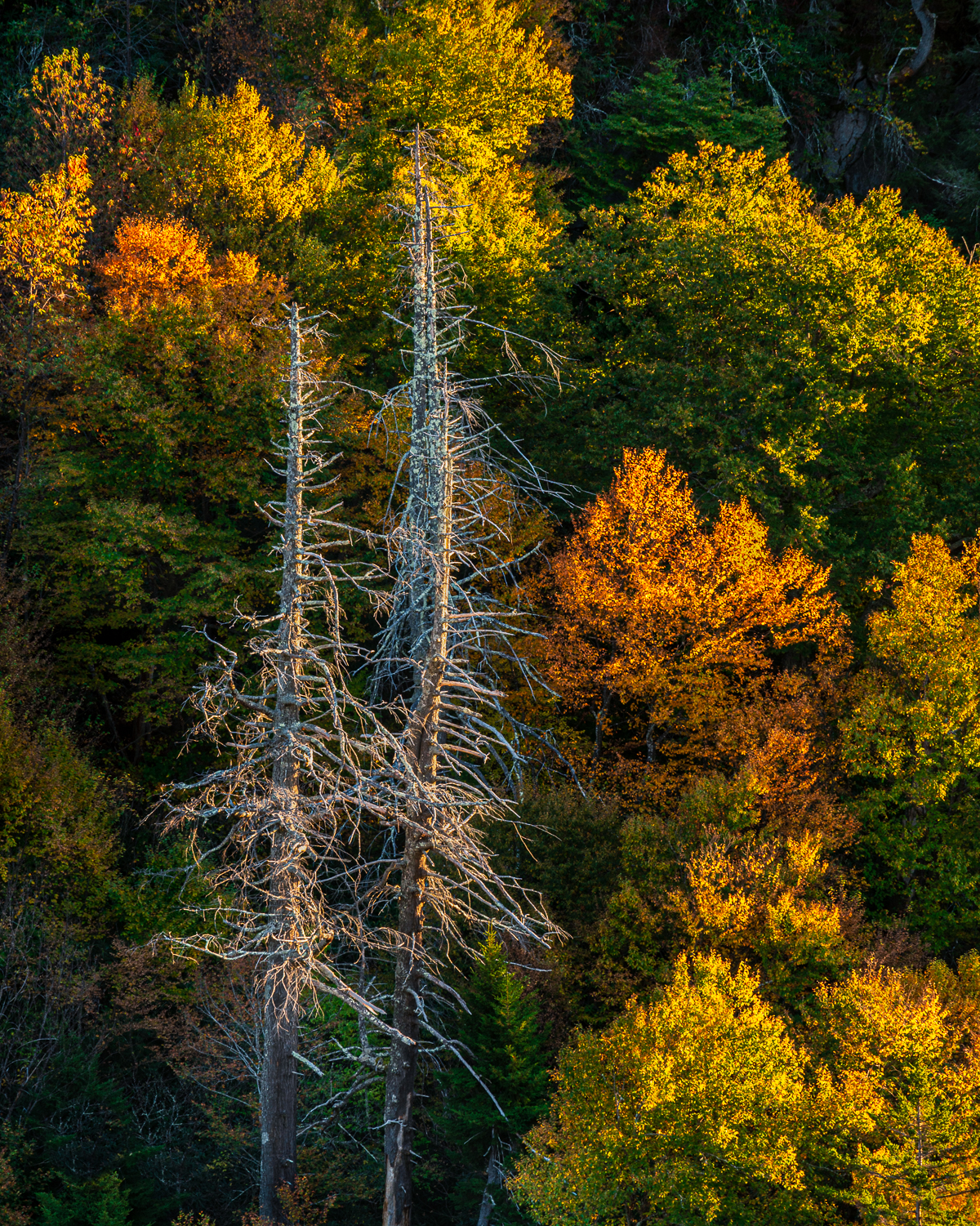
I then headed just up the road to Graveyard Fields again hoping there might be some mist low in the bowl shaped valley. No luck there either, and I was faced with the same problem as before, trying to find something to use as a focal point, and simply fell flat, although trying until the sunlight lost it’s edge.
Going through some old (2012) images, I found one of Graveyard Fields (directly below) that didn’t even register with me as memorable at the time, yet somehow it was marked with 5-stars which is usually reserved for images slated for printing at some point. Yet it was never printed, and was lost in the labyrinth of computer memory for about eight years. It seems that the photo was taken 4 days earlier in the season and shows much more in the way of leaves than that above, indicating that more time needs to be spent at one particular place to see all the possibilities it has to offer as the season progresses. The similarities between this photo taken in 2012 and the final one below, basically resides in the very subtle center of interest as explained further on.
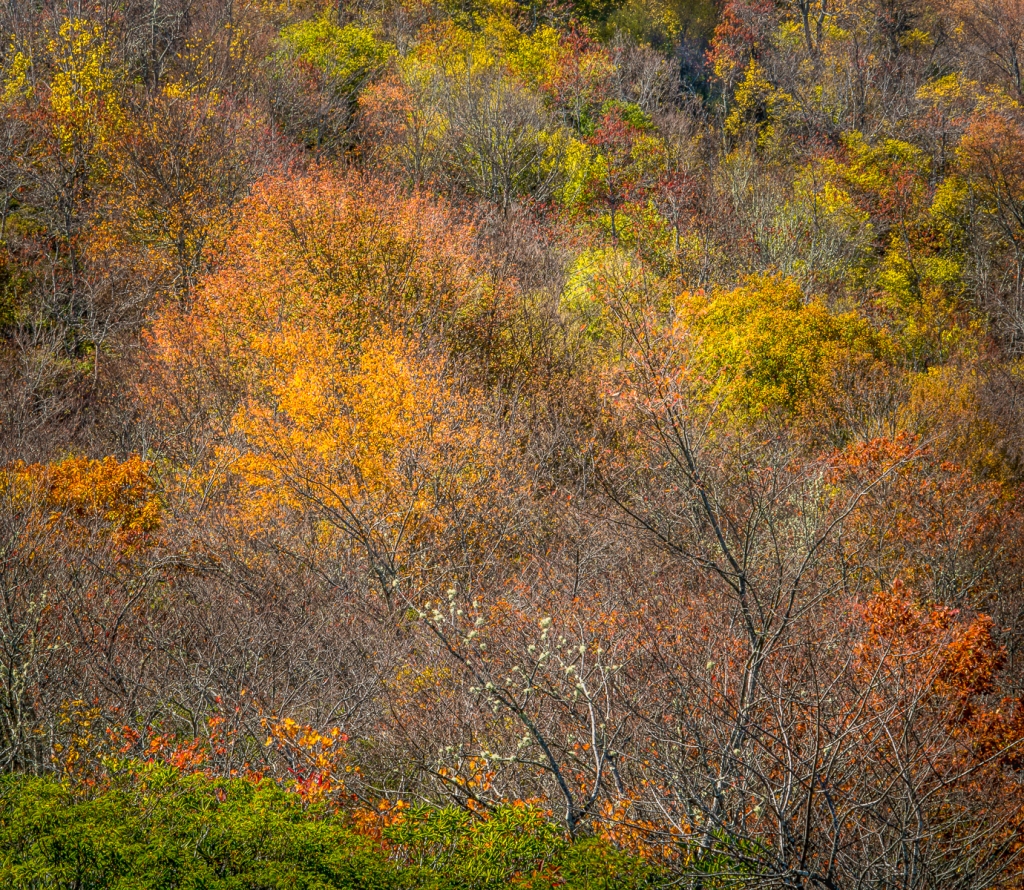
Thinking the entire morning had been a bust, and about to head back to camp to break down the tent, I noticed one section still in shade, of a thick tangle of branches directly below. There were just a few leaves hanging on, and only the most subtle of subject within the frame, but it was enough for me to go back to the car for a step stool to gain the needed height to eliminate some leaves that intruded into the bottom of the frame. This was important in order to have an unobstructed view of the horizontal branch at the bottom which provided a bit of a base for the entire image.
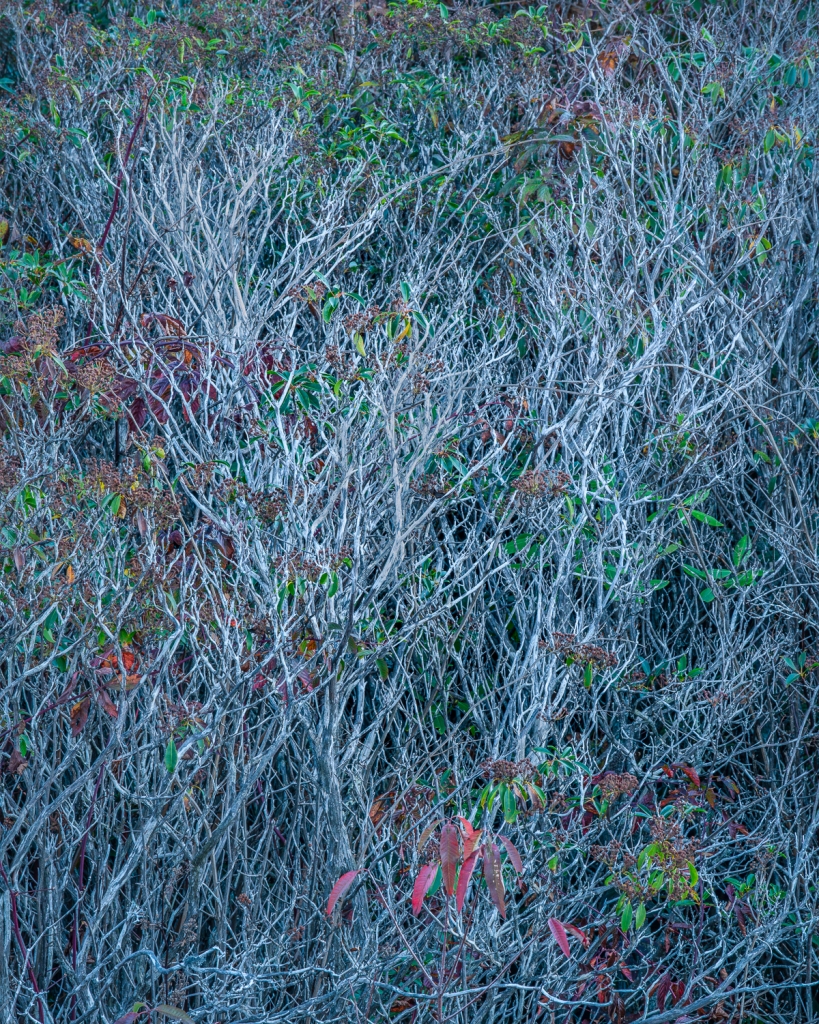
While it is not the most obvious of subjects, it doesn’t jump off the page, but it reminded me of a similar shot taken this past spring of some wild wisteria and red maple buds that also had a very subtle shape within the wild colors and tangle of branches, flowers and buds (Click Here to see that post). It is the same for the image above, something on the order of a drip painting by Jackson Pollock, where seemingly random lines actually form a cohesive form within the frame. Is it a strong photo? For most folks, it will probably leave them scratching their head. But it is for the viewer to decide. After all, I’ve seen an award winning photograph of the side of a house that left me scratching my head as well.
For a short trip, two sunsets and two sunrises, there were a few decent images to go home with. But I was hoping for a spectacular sky at some point to match some of those I’ve witnessed along this glorious roadway in the past. But it was not meant to be which will keep pushing me to head back there again for another short trip.